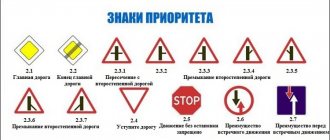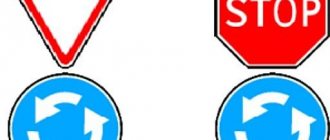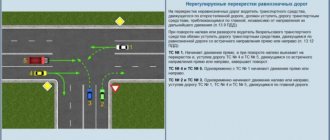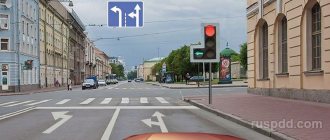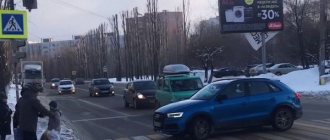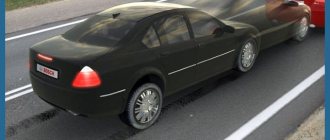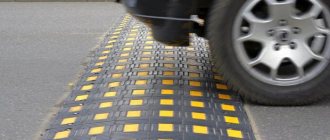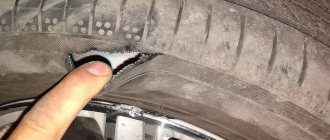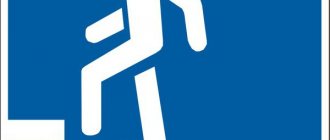In this topic, we will figure out why this sign was invented, what role it plays in traffic rules, because without knowing the basics of traffic rules, you can find yourself in an awkward situation, which will ultimately lead to an accident on the road.
Dear readers! Our articles talk about typical ways to resolve legal issues, but each case is unique. If you want to find out how to solve your particular problem, please use the online consultant form on the right or call ext. 647. It's fast and free!
What does the road narrowing sign mean and what does it look like?
Road narrowing belongs to the category of warning signs and is installed:
- In the city, according to traffic rules, it is installed at a distance of approximately 100 meters from the beginning of the site
- Outside the city on the highway at a distance of an average of 200 meters.
- Outside the populated area, it is re-installed 50 meters before the dangerous area.
Even people who graduated from driving school a long time ago and may have forgotten some traffic rules will understand it. After all, there is nothing complicated in its structure. The sign itself looks like a triangle with a red border and signals a decrease in the number of lanes and the need to change lanes.
If a road sign has an unusual yellow background, this means it is temporarily in this place and is installed in places where road work is being carried out. But there are times when the one established in this place and the temporary one contradict each other. In this situation, you should be guided by temporary signs.
Types of road narrowing sign
It has three different types:
- 1.20.1 - the road narrows both on the right and on the left;
- 1.20.2 - the road narrows on the right;
- 1.20.3 - the road narrows on the left.
They all look almost the same.
Signs warn the driver that one of the lanes will soon end and there is a need to change lanes. Usually the sign is also accompanied by markings on the road, but if there are none, you should pay more attention to the signs.
1.20.1 - narrowing of the road on both sides is much less common than 1.20.1 and 1.20.2. It happens that a three-lane road turns into a one-lane one. In this case, you need to be even more careful, because cars change lanes on both the right and left into one lane, and you will need to know who is giving way to whom when changing lanes.
What is Bandwidth
Capacity is the number of vehicles that can theoretically travel on a road in a period of time. The capacity indicator is calculated by specialists for different types of roads and is taken into account during the design: the required number of lanes and maximum speed are selected depending on how many cars need to be accommodated on the road.
For example, according to recommendations for road design, a district street in a city should carry 500 cars per lane per hour. Therefore, if you want to let more cars through, make another lane or change the type of road to a main road.
Cases when you may encounter this sign
Situations on the road are different. This sign can be found:
- in the city
- outside the populated area.
But it is quite difficult to find it in the city; it is usually replaced by road markings.
So, the main cases when you may encounter this sign:
- The sign is found in those places where one of the stripes ceases to exist. And it’s good if you know this section of the road and can change into the desired lane in advance, but for drivers who drive here for the first time, narrowing the road can cause a lot of trouble in the city. For example, you are driving through the city and see a narrowing road in front of you. You are faced with the need to change lanes, but there is a dense flow of cars in the adjacent lane, which does not give you room to maneuver. And you have to either slow down too much, or stop completely and wait until they let you pass or there is enough distance between the cars so that you can change lanes. But don't forget to turn on your turn signals when changing lanes.
- This sign can also be found at road work sites. As we said, its difference is the yellow background of the sign. In this case, the lane on the road is simply fenced off by road workers and it becomes temporarily inaccessible for traffic.
- The sign is installed in places where you exit from a minor road onto a wide highway or avenue.
- The sign can also be found before passing under a bridge, where the road usually narrows from several lanes in one direction to one lane.
Situations where there is no warning sign
There are also situations when there is no sign and the road narrows. What to do in this case? It's quite simple. You must follow other travel rules.
Considering that your lane is ending, when changing lanes you must give way to other cars moving without changing direction.
This is stated in rule 8.4, because when you change lanes into an adjacent lane, you will be an obstacle for other cars. And don't forget to turn on your turn signals to give advance warning of your maneuver.
The bus has no right of way because it is changing lanes
There is not much text of the Rules regulating this situation; people who adhere to this version, let’s call them “side A,” do not resort to interpretation, but reason strictly according to the text.
- Is the bus leaving its occupied lane? -Yes.
- Does the bus change direction? -No.
What does it look like from the driver's side in the left lane?
The bus turns on the turn signal and starts moving in its lane, the driver moves along the free left lane, the requirement to give way to the bus does not arise, since their trajectories do not intersect.
The bus starts moving
If you give the bus an advantage, then the advantage cannot be in one situation and absent in another. Let’s imagine that the bus starts moving from the stop straight to the outer lane, crossing the middle lane, or starts turning around from the stop, or is there no obstacle? If the bus starts to make a U-turn when it starts moving, the question does not arise: is it turning around or not? Why does the question arise: is it being rebuilt or not?
The bus starts moving from the left lane
The bus has an advantage only when going around an obstacle - this is not written in the Rules. The advantage, if we consider both sides, is either always there when starting a movement, or it is exclusively when starting a movement without associated maneuvers.
Who must yield when approaching a narrowing road sign?
- According to traffic rules, the driver must give way to passing traffic. But it happens that the flow is too dense and there is practically no opportunity to change lanes into it. Usually, drivers have their own rules. Seeing that your road is narrowing, they may let you into the stream. But there are also situations at an intersection where not everyone is ready to yield, and in this case, be patient and wait, but remember for the future to change lanes in advance. Don’t forget that you don’t need to blatantly move into another lane, interfering with other road users, because you are not only breaking traffic rules by not giving way, but you can also get into an accident in which you are found guilty.
- When changing lanes from the right and left lanes at the same time, it is necessary to use the “right hand” rule, and in this case, the one with interference on the right must yield. Those. If you change lanes from the left lane and at the same time another car changes lanes from the right, then it is an obstacle for you on the right, according to this rule, it must pass first, and you give way to it. And vice versa, when you are trying to change lanes from the right lane, and at the same time a car is driving from the left lane, then you have the advantage. But do not forget that not all drivers can do this. For example, a young driver who has just graduated from a driving school may get confused on the road, or a very arrogant motorist for whom the rules are not written, in this situation it is better to give in to them so as not to end up in an emergency.
Always remember that compliance with traffic rules is the key to your safety. Never forget to look at the signs, because they are installed for a reason, but to warn drivers about a possible danger or situation on the road. And if you ignore them, you can get into an accident or find yourself in an incomprehensible situation on the road.
Didn't find the answer to your question? Find out how to solve exactly your problem - call right now: +8 ext. 647 (all over Russia) It's fast and free!
Free online consultation with a car lawyer
Didn't find the answer to your question? Find out how to solve exactly your problem - call right now: +8 ext. 647 (all over Russia) It's fast and free!
What's the problem with bandwidth?
Russian officials are very concerned about the throughput indicator and consider it the main criterion for combating traffic jams. In their opinion, the more this theoretical indicator is on the road, the less traffic jams there are. Therefore, to get rid of congestion, they widen roads, create new lanes and increase the speed limit - all of which increases the value of traffic capacity.
The problem is that throughput is a purely theoretical maximum indicator of a lane “in a vacuum”; in reality, these values are not achieved, especially in the city, due to road intersections, traffic lights, driver reaction speed, asphalt condition, and so on.
This indicator is used for calculations by designers when they need to understand what type of road to build. In the fight against traffic jams, throughput does not matter much.
Narrowing roads is the right thing to do
It's understandable why people resist proposals to narrow roads and calm traffic. It seems logical that narrow roads with few lanes would have more traffic jams. However, the correct conclusion is counterintuitive.
Narrow streets are better than wide main roads: they are safer, they are a comfortable environment for people, they respect human scale and are built into the urban environment.
On narrow roads, losses in throughput are minimal (see studies above), and they should not be taken into account. It is necessary to increase the carrying capacity of roads; these terms and their meaning should not be confused. What matters is how many people, not cars, the road can handle.
Is it possible to challenge a fine?
Modern drivers are more educated than their colleagues 20-30 years ago, so they easily enter into disputes with representatives of law enforcement agencies responsible for enforcing traffic rules. We recommend doing this only in cases where you are absolutely sure that you are right. Situations with passing SD signs are interpreted quite unambiguously, so here your chances of avoiding punishment in the event of an obvious violation are minimal. The traffic police officer is not obliged to inform you that your violation was recorded by appropriate technical means, so you take a big risk by filing an appeal. We do not encourage you to negotiate on the spot, especially since this violation is subject to the law on a twofold reduction in the amount of the fine, provided it is paid within 10 days. In any case, the fine is not so large as to require an auto lawyer to get involved. Just try not to break the Rules in the future.
Tapering options
The driver’s actions in a situation with the signs in question directly depend on which side the narrowing will occur.
- If the situation narrows on the right, that is, the right lane on the sign is curved, then those moving along this lane, that is, on the right, are required to change lanes. They should carefully move to the left;
- If the narrowing is on the left, then on the contrary they will have to go to the right;
- When the situation forces you to narrow on both sides at once, the transition is simply to the middle lane.

